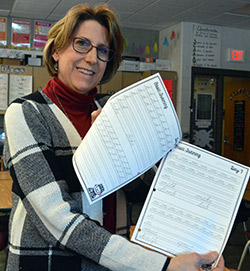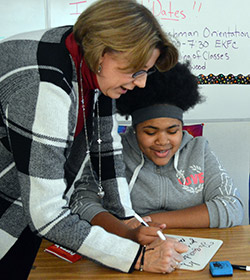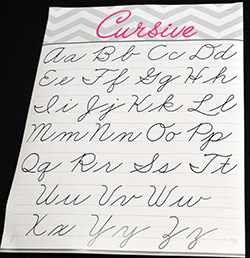The curly, connected flow of cursive seems like ancient text to students today, who are more used to writing with clicks of a keyboard than with perfect penmanship.

“It looked like a little scribble,” said Crestwood Middle School seventh grader Alexia Jackson. A grownup scribble, she clarified. “When I was little I would scribble and say, ‘I’m an adult.’
But now she can read the cursive sentence on the classroom projector: “The quick brown fox jumped over the lazy dog” and copy it with dexterity.
During after-school Cursive Club, Alexia and her peers spent several minutes carefully writing a poem in cursive for a competition. Students will be judged on overall best writing, best slant, best sizing neatness and form by teacher Anne Brown.
After the final line, Alexia moved on to practicing stately capital letters, fancy Fs and elegant Ls.
Brown, who teaches middle school language arts, started Cursive Club several years ago after she noticed students didn’t know how to sign their names. They hadn’t learned cursive in elementary school — at least not to the extent of previous generations. Instead, they eyed the artistic style with curiosity. Take sixth grader Reign Brown, who said “When I was in third grade I would try to copy my mom’s handwriting.”
Conserving Cursive

Brown took action to save cursive from its inky spiral toward antiquity. She points to a host of benefits to learning the longform style. Research shows it fires both sides of the brain, develops fine motor skills and hand-eye coordination, requires focus and attention to detail, and is faster than printing.
Plus, she wants students to be able to read handwritten documents, and have their own John Hancocks. “They aren’t going to be able to read the Declaration of Independence,” Brown said, about one consequence of not learning cursive.
Cursive was an elementary staple for those schooled before the dawn of online assessments, Google Docs and texting. Today’s education standards, however, have largely declared it obsolete, giving it lower priority than technology and typing skills.
“We threw the baby out with the bathwater,” said Brown, who gives her students extra credit for completing vocabulary assignments in cursive. “With keyboarding and computers, it’s not valued like it was. I have a firm belief that we need to remember there are other things that come from it that have to do with the brain and being able to read primary documents… I think it will be a bigger issue than people think.”

Brown believes in blending the old with the new in her classroom. “Not everything in the past is bad. I’m all about keyboarding and using the computer; there’s a place for that, but there’s a place for this too.”
While her eight-week club isn’t quite enough time to yield perfect penmanship, her students come a long way, she said. She gives them tips while they practice: “O’s go up and around.” “You don’t want that much space here.” “Try not to lift your pencil between words.”
The more than 20 students in the club include boys and girls, some, like Jay Inagandi, whose parents signed him up because he couldn’t read his grandma’s writing. “I couldn’t read any of my birthday cards,” Jay said.
Many students said they think cursive is pretty, along with being useful. “I think it’s really cool to write it, and I like how it looks,” said seventh grader Taniya Stacy.
As for Alexia, she feels more looped in than ever. “I think it’s a beautiful practice. It helps us connect with our parents and grandparents. They write like this a lot of the time, so now we can see it, feel it and love it.”














